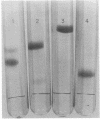Abstract
In order to determine the chemical features of human placental lactogen (hPL) necessary for its biologic activity we prepared the following fragments from the plasmin-cleaved hormone: reduced and alkylated 1--134, reduced and alkylated 141--191, and a 1--134 dimer joined through the single cysteinyl residue at position 53. In a radioimmunoassay using antibodies against native hPL, the two reduced and alkylated fragments produced nonparallel displacement and had less than 1% of the activity of hPL. The ability of reduced and alkylated 1--134 to bind to mammary gland receptors was less than 5% of that of hPL; reduced and alkylated 141--191 showed no detectable activity in the same assay. The 1--134 dimer, in contrast, had 20% of the immunologic activity and 30% of the ability to bind to lactogenic receptors relative to the native hormone. In an in vitro bioassay the lactogenic activity of the 1--134 dimer was equivalent to that of the native hormone. The circular dichroic spectra of hPL, reduced and alkylated 1--134, and 1--134 dimer indicated that the dimer had regained much of the helical content of the native hormone. Antibodies produced to reduced and alkylated 1--134 did not significantly crossreact with either native hPL or 1--134 dimer. From these data we conclude that the information for the lactogenic activity of hPL is contained in the first 134 amino acid residues and that the proper conformation is necessary for its biologic expression.
Full text
PDF



Images in this article
Selected References
These references are in PubMed. This may not be the complete list of references from this article.
- CRESTFIELD A. M., MOORE S., STEIN W. H. The preparation and enzymatic hydrolysis of reduced and S-carboxymethylated proteins. J Biol Chem. 1963 Feb;238:622–627. [PubMed] [Google Scholar]
- Chillemi F., Aiello A., Pecile A. Synthesis of human growth hormone fragments with growth-promoting activity. Nat New Biol. 1972 Aug 23;238(86):243–245. doi: 10.1038/newbio238243a0. [DOI] [PubMed] [Google Scholar]
- Handwerger S., Pang E. C., Aloj S. M., Sherwood L. M. Correlations in the structure and function of human placental lactogen and human growth hormone. I. Modification of the disulfide bonds. Endocrinology. 1972 Sep;91(3):721–727. doi: 10.1210/endo-91-3-721. [DOI] [PubMed] [Google Scholar]
- Hara K., Hsu Chen C. J., Sonenberg M. Recombination of the biologically active peptides from a tryptic digest of bovine growth hormone. Biochemistry. 1978 Feb 7;17(3):550–556. doi: 10.1021/bi00596a028. [DOI] [PubMed] [Google Scholar]
- Li C. H., Bewley T. A., Blake J., Hayashida T. Human somatotropin: restoration of full biological activity by noncovalent interaction of a natural and a synthetic fragment of the hormone. Proc Natl Acad Sci U S A. 1977 Mar;74(3):1016–1019. doi: 10.1073/pnas.74.3.1016. [DOI] [PMC free article] [PubMed] [Google Scholar]
- Li C. H., Bewley T. A. Human pituitary growth hormone: restoration of full biological activity by noncovalent interaction of two fragments of the hormone. Proc Natl Acad Sci U S A. 1976 May;73(5):1476–1479. doi: 10.1073/pnas.73.5.1476. [DOI] [PMC free article] [PubMed] [Google Scholar]
- Li C. H., Gráf L. Human pituitary growth hormone: isolation and properties of two biologically active fragments from plasmin digests. Proc Natl Acad Sci U S A. 1974 Apr;71(4):1197–1201. doi: 10.1073/pnas.71.4.1197. [DOI] [PMC free article] [PubMed] [Google Scholar]
- Li C. H. Human pituitary growth hormone: a biologically active hendekakaihekaton peptide fragment corresponding to amino-acid residues 15-125 in the hormone molecule. Proc Natl Acad Sci U S A. 1975 Oct;72(10):3878–3882. doi: 10.1073/pnas.72.10.3878. [DOI] [PMC free article] [PubMed] [Google Scholar]
- Loewenstein J. E., Mariz I. K., Peake G. T., Daughaday W. H. Prolactin bioassay by induction of N-acetyllactosamine synthetase in mouse mammary gland explants. J Clin Endocrinol Metab. 1971 Aug;33(2):217–224. doi: 10.1210/jcem-33-2-217. [DOI] [PubMed] [Google Scholar]
- Mills J. B., Kostyo J. L., Moseley M. H., Reagan C. R., Wilhelmi A. E. Isolation and characterization of fragments of reduced and S-carbamidomethylated human growth hormone produced by plasmin digestion. I. Chemistry. Endocrinology. 1978 May;102(5):1366–1376. doi: 10.1210/endo-102-5-1366. [DOI] [PubMed] [Google Scholar]
- Rao A. J., Ramachandran J., Li C. H. Human pituitary growth hormone. 44. Effects of plasmin-modified hormone and its fragments on ornithine decarboxylase activity and lipolysis. Proc Soc Exp Biol Med. 1976 Feb;151(2):285–287. doi: 10.3181/00379727-151-39193. [DOI] [PubMed] [Google Scholar]
- Reagan C. R., Mills J. B., Kostyo J. L., Wilhelmi A. E. Isolation and biological characterization of fragments of human growth hormone produced by digestion with plasmin. Endocrinology. 1975 Mar;96(3):625–636. doi: 10.1210/endo-96-3-625. [DOI] [PubMed] [Google Scholar]
- Schneider A. B., Kowalski K., Buckman G., Sherwood L. M. Dimeric ("big") human placental lactogen. Immunological and biological activity. Biochim Biophys Acta. 1977 Jul 22;493(1):69–77. doi: 10.1016/0005-2795(77)90260-4. [DOI] [PubMed] [Google Scholar]
- Schneider A. B., Kowalski K., Sherwood L. M. Identification of "big" human placental lactogen in placenta and serum. Endocrinology. 1975 Dec;97(6):1364–1372. doi: 10.1210/endo-97-6-1364. [DOI] [PubMed] [Google Scholar]
- Tsushima T., Friesen H. G. Radioreceptor assay for growth hormone. J Clin Endocrinol Metab. 1973 Aug;37(2):334–337. doi: 10.1210/jcem-37-2-334. [DOI] [PubMed] [Google Scholar]
- Weber K., Pringle J. R., Osborn M. Measurement of molecular weights by electrophoresis on SDS-acrylamide gel. Methods Enzymol. 1972;26:3–27. doi: 10.1016/s0076-6879(72)26003-7. [DOI] [PubMed] [Google Scholar]



